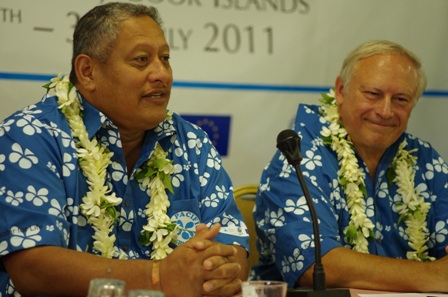News
YES | 1 | YES
Regional Water experts meet to address Pacific's Water and Sanitation Issues
27 July, 2011


Tuesday, July 26, Rarotonga, Cook Islands: Delegates from Pacific Islands countries gathered in Rarotonga, the Cook Islands today for a week long meeting to discuss the region’s water and sanitation issues. They were reminded that finding solutions to pressing water and sanitation problems was urgent and vital to the future development and health of the Pacific’s people and environment.
“The work we are here to discuss, and plan a way forward for, represents one of the region’s most critical struggles, the struggle to protect the rights of men, women, boys and girls to safe water and sanitation,” said Dr Russell Howorth Director of the Secretariat of the Pacific Community’s Applied Geoscience and Technology Division (SOPAC). “The scarcity of freshwater resources continues to pose several problems for the region. Localised pollution, excessive sedimentation due to uncontrolled watershed development and water wastage are common problems. Water shortages force some atoll communities to use contaminated or salty groundwater for cooking and drinking.”
“Death and disease occur through natural disasters such as floods, droughts and heat waves, which bring about a reduction in the availability of freshwater and a gradual decrease in water quality,” Dr Howorth said. “Over the long term, climate change is expected to make issues even more important as frequency and intensity of events are predicted to rise.”
Dr Alfred Duda, Senior Advisor on International Waters to the Global Environment Facility, congratulated delegates for their efforts so far but urged them to work harder on reforms.
“Are your island states serious about addressing this issue? Are you ready to work with communities and ministers from different sectors to make the investments and reforms needed in water and sanitation?”, Dr Duda asked. “If you’re serious we want to be with you, and work towards solving these problems once and for all for your islands and future.
The GEF is funding a regional and nationally based project to build the capacity of Pacific Island countries to manage water resources. 14 demonstration projects will be run in 13 Pacific countries to show the practical benefits of integrated sustainable water resources and wastewater management.
Dr Duda said that efforts made now by Pacific island governments on institutional and sectoral reform was key to securing to future funding for water and sanitation.
“We place a priority on your island issues. That’s why we can work on water and sanitation issues here. Water supply and sanitation need to be done differently. These reforms that you think are needed, need to be embedded into government institutions,” Dr Duda said. “The more we know about your results the better able we will be to bring your requests for more funding forward.”
According to Dr Duda the demonstration projects being run in the Pacific have global significance as they will inform how countries with bigger basins address water and sanitation issues.
“We’re only now in these large basins getting to the scale where you are. Your success is critical to the GEF international waters area. The reforms are going to be critical.”
In his opening address the Cook Islands Minister for Infrastructure and Planning, the Honorable Teariki Heather, urged all partcipants “to take the meeting as a serious collective effort by Pacific Island Countries”. “Water and sanitation is vital to the quality of life and the economic development of every Pacific island country and it is also a human right.”
“The meeting is timely - as the Cook Islands has tended to in the past neglect water and wastewater of the Pacific Community’s (SPC) Applied Geoscience and Technology Division (SOPAC). management and is witnessing the impacts of this neglect,” Mr Heather said. “I realise the significance of the GEF demonstration projects as a way of showing the way forward and demonstrating on the ground how the current situation can be improved and urge Dr Duda to support future International Waters projects in the Pacific.”
The GEF demonstration projects are being supported in their move towards Integrated Water Resources Management (IWRM) by a European Union (EU) funded IWRM planning programme, based at SOPAC, that is working with countries to develop national planning and water policies based on IWRM principles. The EU has spent €25 million between 2003 and 2008 on the water sector in the Pacific.
“The European Commission together with the EU Member States are aware of the need of assistance to the Pacific region to overcome such challenges, since it takes a collective global effort to make sure that this diverse region experiences sustainable development,” Marius-Adrian Onacea, from the Delegation of the European Commission for the Pacific said. “Under the 10th European Development Fund, 2009 – 2013, the total EU contribution to the same sector increased to almost €36 million. These initiatives intend to contribute to better standards of health and life for their beneficiaries.”
Ms Ampai Harakunarak of the United Nations Environment Programme noted the steady progress of implementation at both national and regional level.
“Such an encouraging level of progress cannot be successfully implemented without strong political commitment of the Pacific countries as well as active engagement of all partners and stakeholders at all levels,” Ms Narakunarak said.
The meeting ends Friday, July 29th.
The regional GEF IWRM Demonstration Projects and EU Planning Programme are run by SPC-SOPAC.
CONTACT: Tiy Chung, SOPAC Communications Advisor (currently in the Cook Islands): (+682) 2833
















